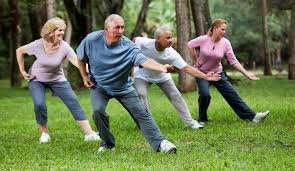Tai Chi: What It Is, Benefits, and More
In a world filled with fast-paced workouts and high-intensity training, Tai Chi stands out as a gentle yet powerful way to strengthen both body and mind. Often described as “meditation in motion,” Tai Chi is more than just slow movements—it’s a centuries-old Chinese practice rooted in martial arts, balance, and energy flow.
Whether you’re seeking stress relief, better balance, or a more mindful connection with your body, Tai Chi offers a holistic approach to wellness. This article explores what Tai Chi is, its physical and mental health benefits, and how to get started, making it a perfect introduction for beginners and enthusiasts alike.
What Is Tai Chi?
Tai Chi (or Tai Chi Chuan) is an ancient Chinese practice that combines slow, deliberate movements, controlled breathing, and focused intention. Originally developed as a martial art, it has evolved into a popular form of exercise and meditation known for promoting physical health, emotional balance, and mental clarity.
At its core, Tai Chi is based on the concept of “Qi” (pronounced chee)—the vital life energy that flows through the body. Tai Chi seeks to balance and enhance this energy through gentle, flowing sequences of movements called forms.
The Origins of Tai Chi
Tai Chi dates back over 700 years and has roots in Taoist philosophy and Chinese martial arts. It was traditionally practiced for self-defense, but over time, its focus shifted toward health, longevity, and spiritual cultivation.
There are several major styles of Tai Chi, including:
- Yang style: Most popular and widely practiced; gentle and slow
- Chen style: More dynamic, with bursts of fast movement
- Wu and Sun styles: Known for small, compact motions and ease for older adults
Mind-Body Connection in Tai Chi
Tai Chi isn’t just about movement—it’s about awareness. Every motion in Tai Chi is done with focus and intention, making it a form of moving meditation. It trains practitioners to be present, listen to their bodies, and breathe deeply and rhythmically.
This makes Tai Chi especially effective for:
- Reducing anxiety
- Calming the nervous system
- Improving focus and mental clarity
Physical Benefits of Practicing Tai Chi
Tai Chi offers a wide range of physical health benefits without the strain of high-impact exercises.
1. Improved Balance and Coordination
Tai Chi enhances proprioception—your body’s ability to sense its position in space. This can reduce the risk of falls, especially in older adults.
2. Increased Flexibility and Strength
Though the movements are gentle, they engage the muscles, especially in the legs and core, helping improve tone and posture.
3. Better Joint Health
Tai Chi puts minimal stress on joints, making it ideal for people with arthritis, osteoporosis, or chronic pain.
4. Cardiovascular Support
While not aerobic in the traditional sense, regular Tai Chi practice can lower blood pressure, improve heart function, and promote circulation.
5. Enhanced Respiratory Function
Deep breathing techniques improve lung capacity and oxygen flow, supporting energy and endurance.
Mental and Emotional Benefits
Beyond physical perks, Tai Chi has profound effects on mental well-being.
1. Stress Reduction
The rhythmic, slow pace of Tai Chi combined with deep breathing helps relax the body and quiet the mind, lowering cortisol levels.
2. Improved Sleep
Regular practice has been linked to better sleep quality, especially in people struggling with insomnia or anxiety.
3. Boosted Mood and Mindfulness
Tai Chi has been shown to alleviate symptoms of depression, promote emotional resilience, and increase overall mindfulness.
Is Tai Chi Good for Older Adults?
Absolutely. Tai Chi is low-impact and safe for all age groups, especially older adults. It can:
- Improve mobility
- Reduce fall risk
- Ease joint stiffness
- Offer social interaction in group classes
Many rehabilitation centers and senior programs now include Tai Chi for its evidence-backed benefits on aging.
Tai Chi and Chronic Conditions
Scientific studies support the role of Tai Chi in managing various health issues:
- Arthritis: Increases range of motion and reduces pain
- Fibromyalgia: Reduces fatigue and improves sleep
- Parkinson’s disease: Enhances stability and motor control
- Diabetes: Helps regulate blood sugar through gentle activity
How to Start Practicing Tai Chi
If you’re new to Tai Chi, here’s how to begin:
1. Find a Local Class or Instructor
Look for community centers, health clubs, or martial arts studios offering Tai Chi classes. In-person guidance ensures proper technique.
2. Try Online Videos
If local classes aren’t available, many high-quality Tai Chi tutorials are available on YouTube and wellness platforms.
3. Start with 10–20 Minutes a Day
Begin slowly. Focus on breathing and balance rather than perfection.
4. Wear Comfortable Clothing
Loose, breathable clothing and flat shoes will help you move freely and stay grounded.
5. Be Patient
Tai Chi may feel unfamiliar at first. With regular practice, you’ll start to notice physical and mental improvements
Ready to begin your journey? Read the full guide on Tai Chi and its health benefitsto explore deeper practices and expert tips.
Tai Chi vs. Yoga: What’s the Difference?
While both are mind-body practices, Tai Chi is movement-focused and rooted in martial arts, whereas yoga includes poses and is often more static, with a focus on stretching and holding postures. Both are beneficial and can even be practiced together.
Final Thoughts
Tai Chi is more than just an exercise—it’s a philosophy of balance, awareness, and natural movement. Its gentle yet effective approach makes it accessible for people of all ages and fitness levels.
Whether you’re looking to reduce stress, manage a chronic condition, or improve your physical health, Tai Chi offers a safe and holistic way to reconnect with your body and calm your mind.
Take a deep breath, slow down, and try Tai Chi—you might be surprised at how much power lies in softness.
Let me know if you’d like:
- Meta description
- Tags
- Focus keywords
- A version optimized for Blogger or WordPress posting







